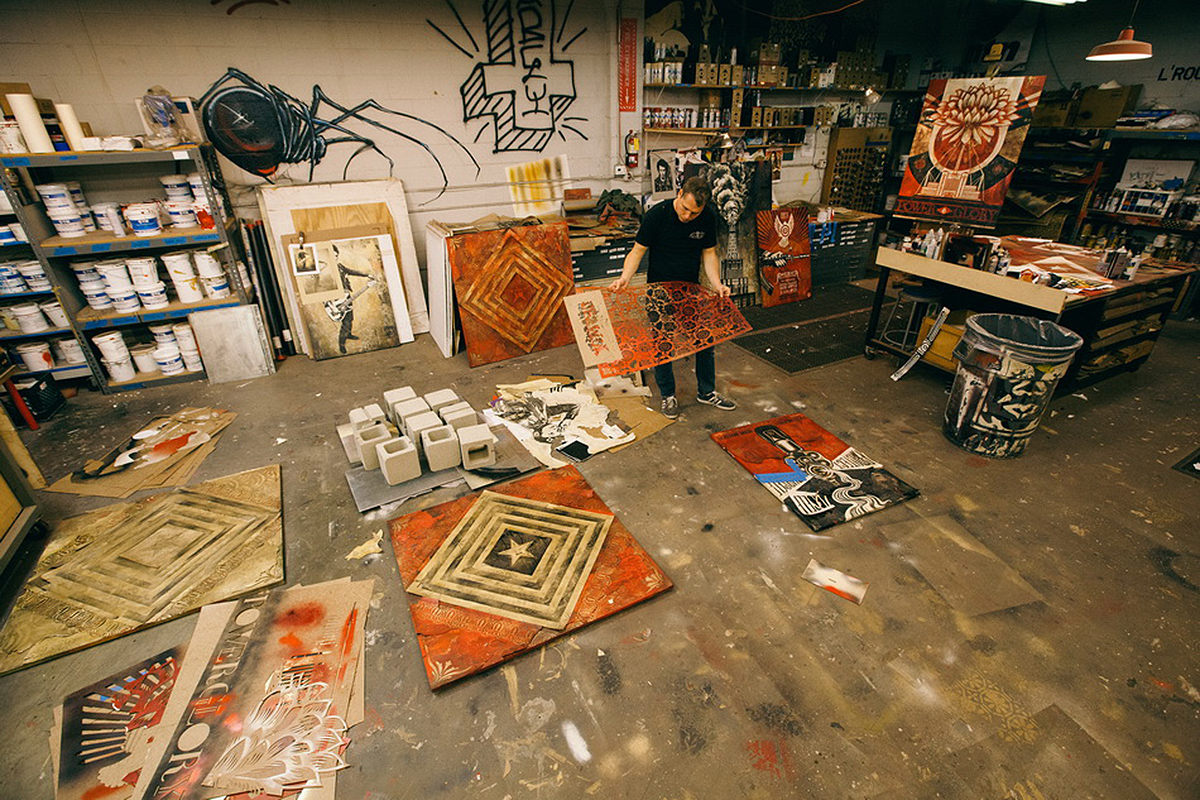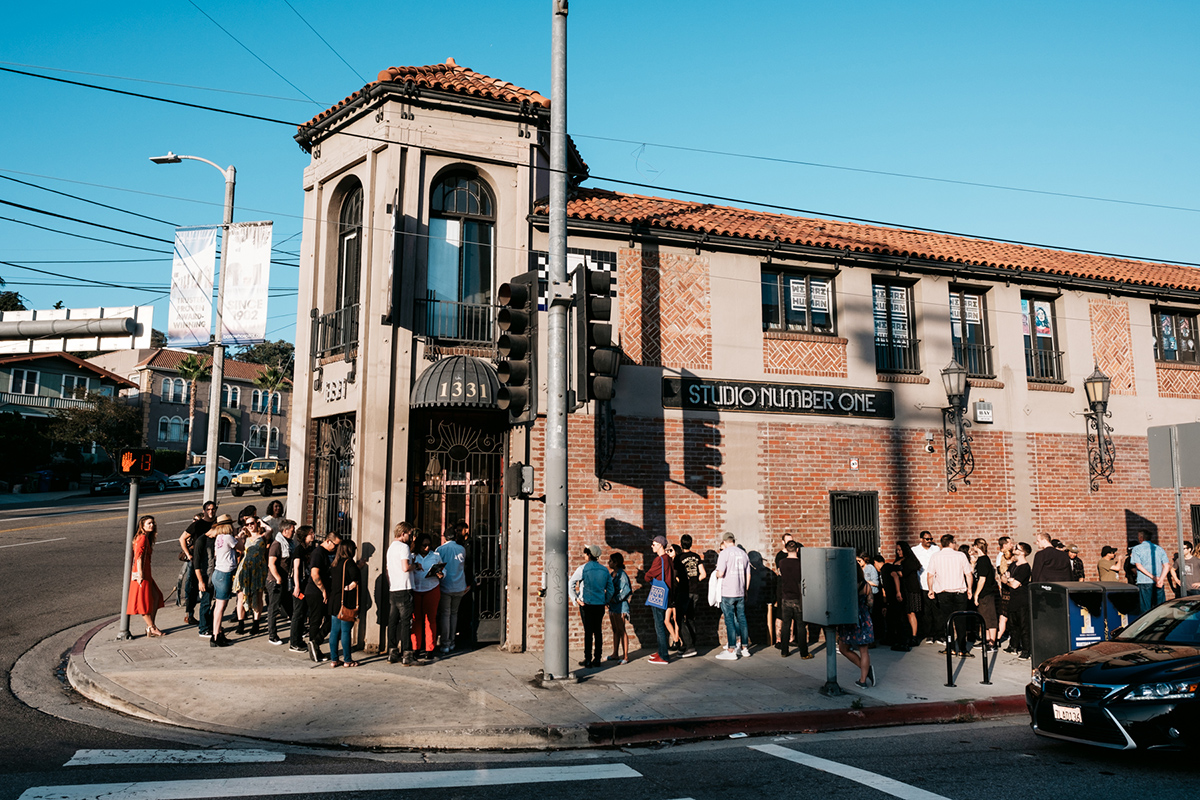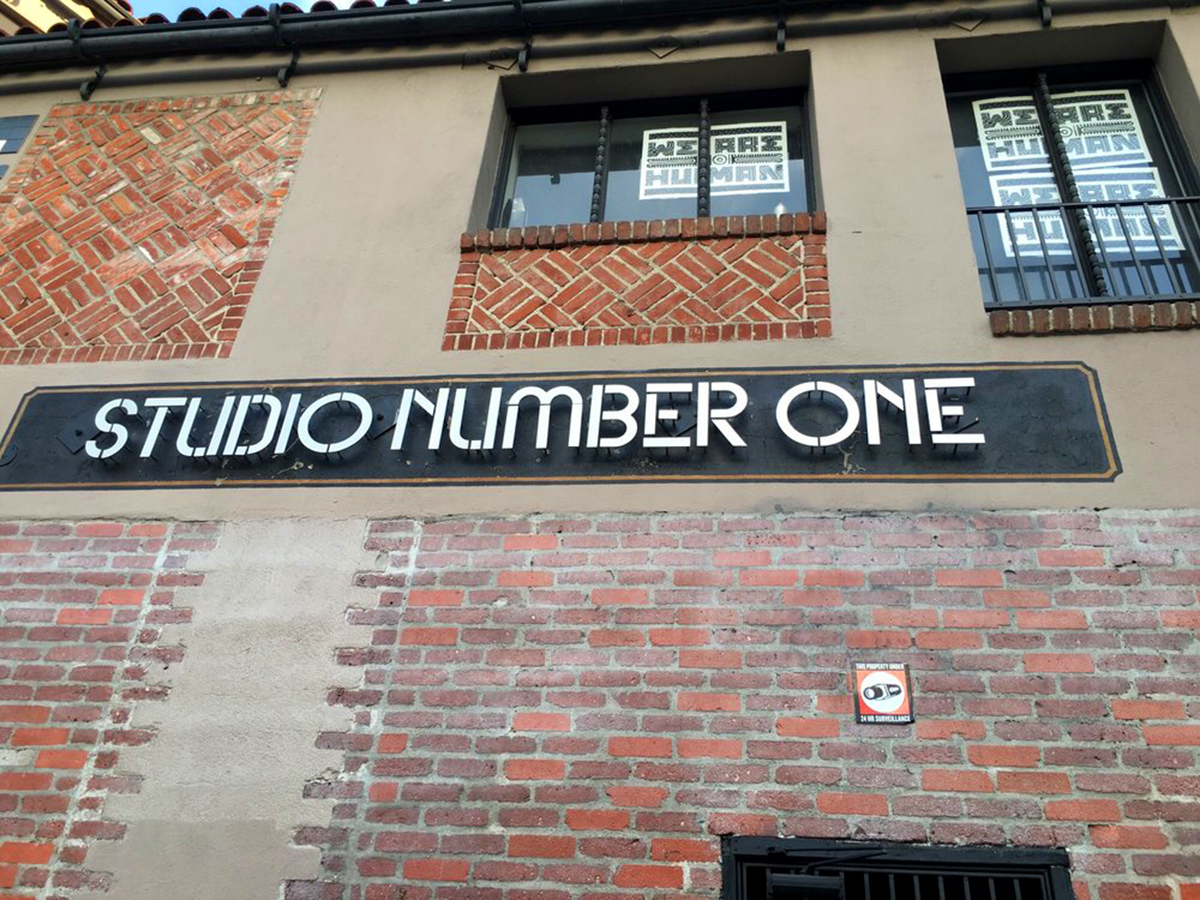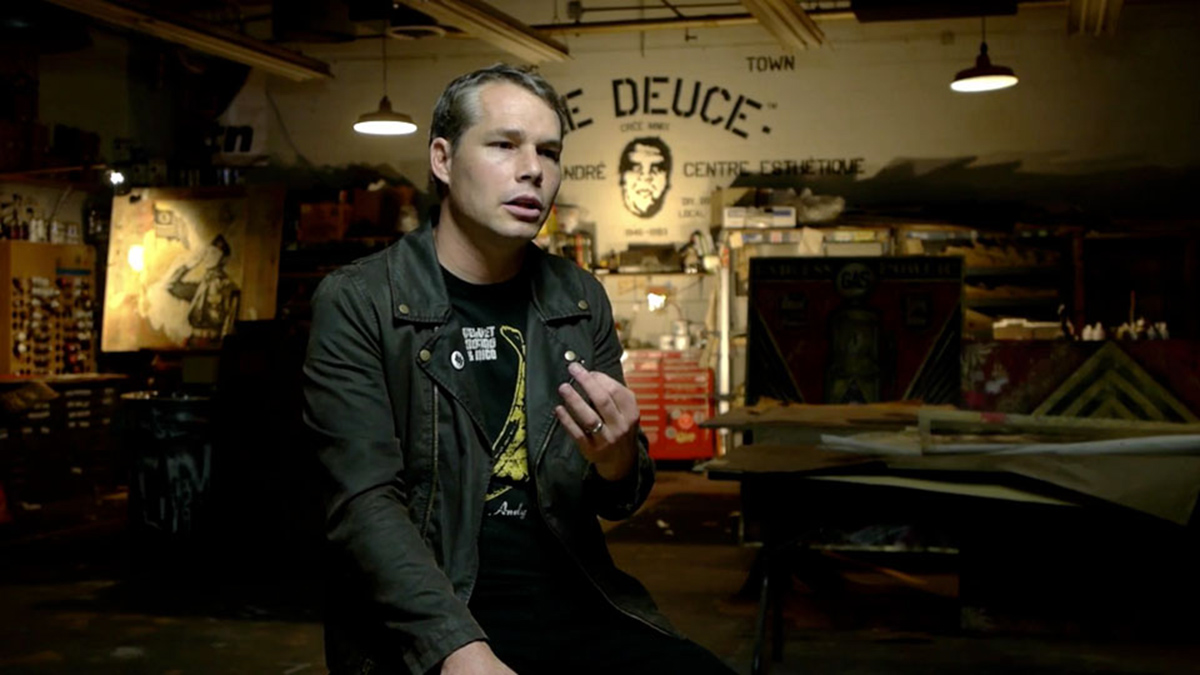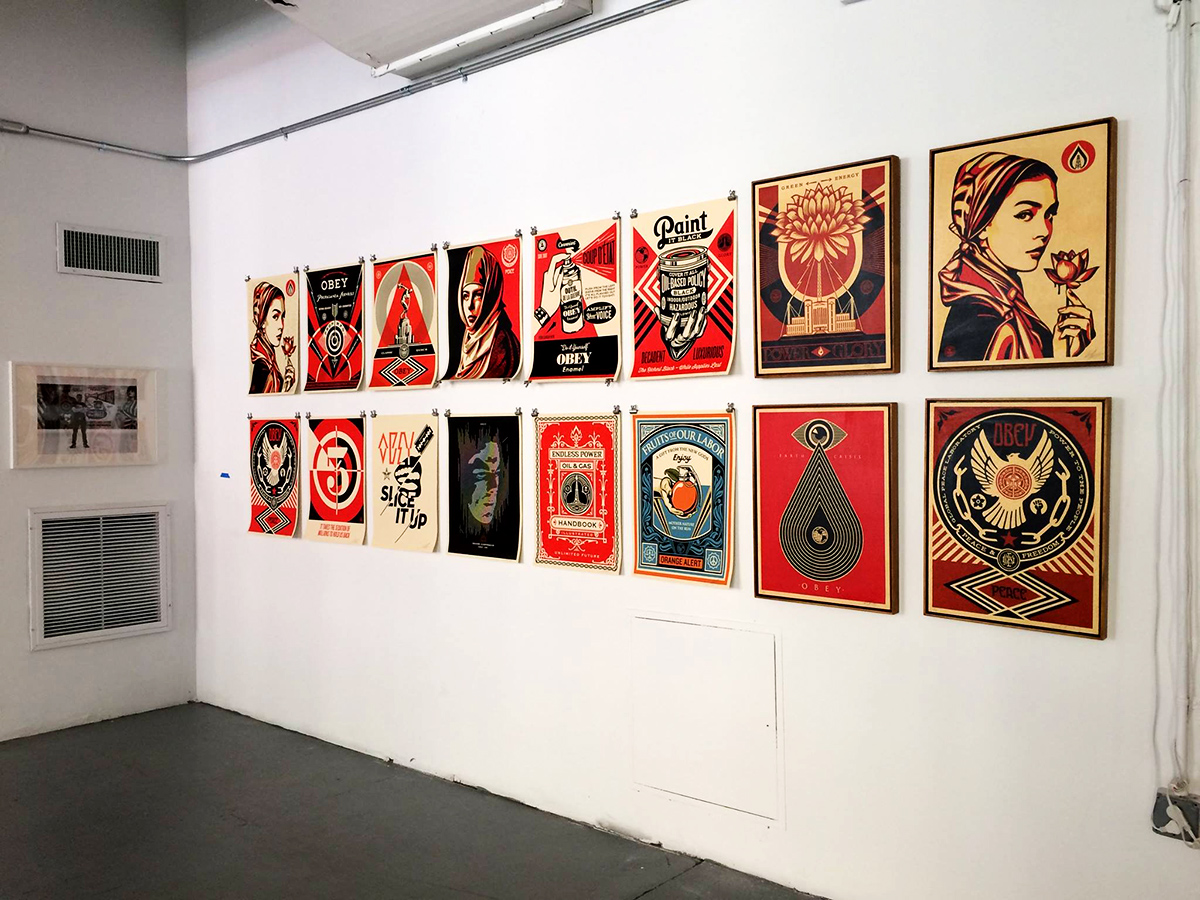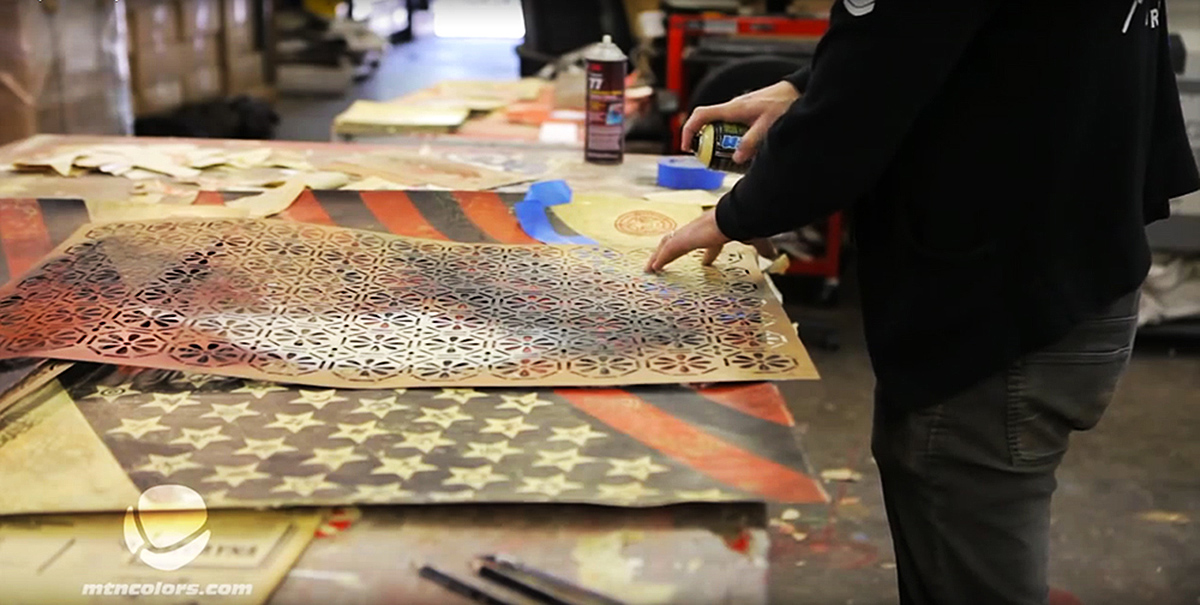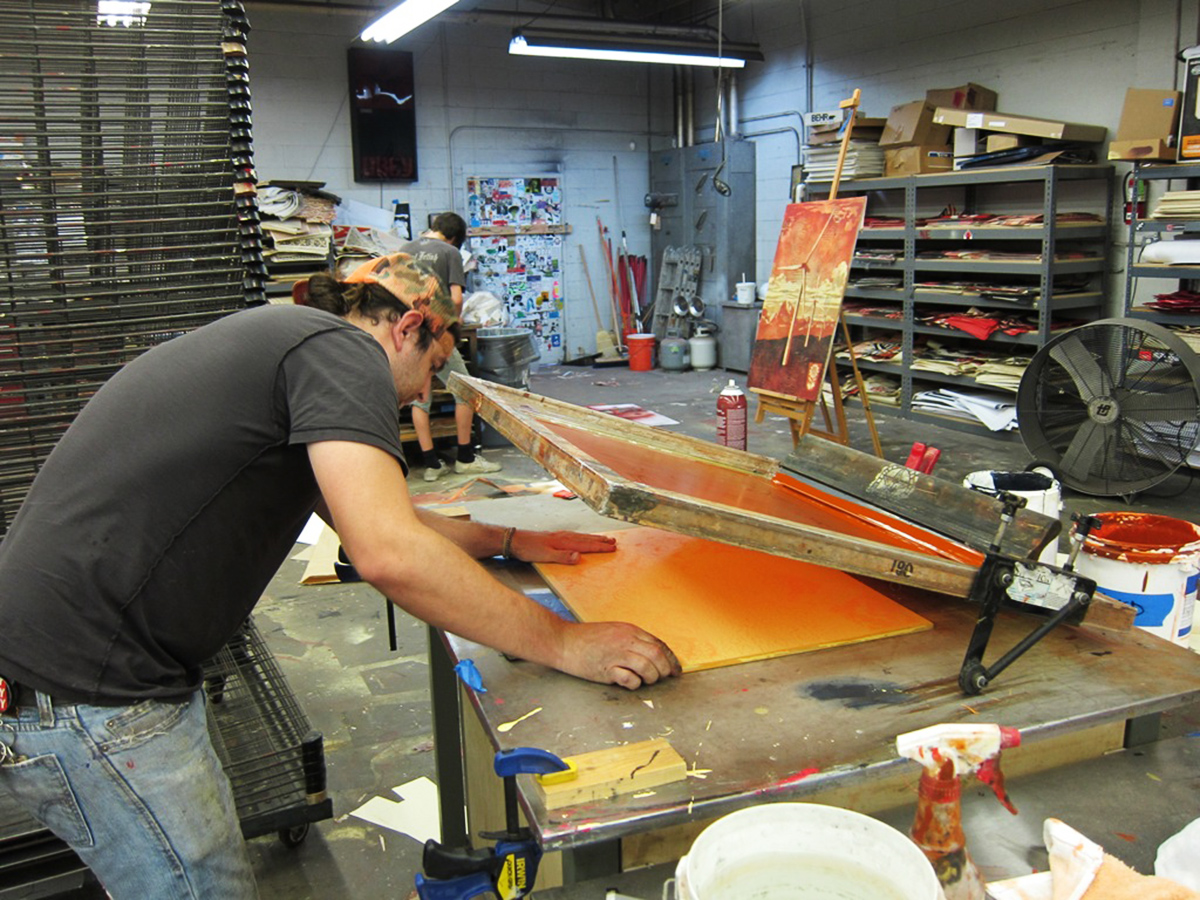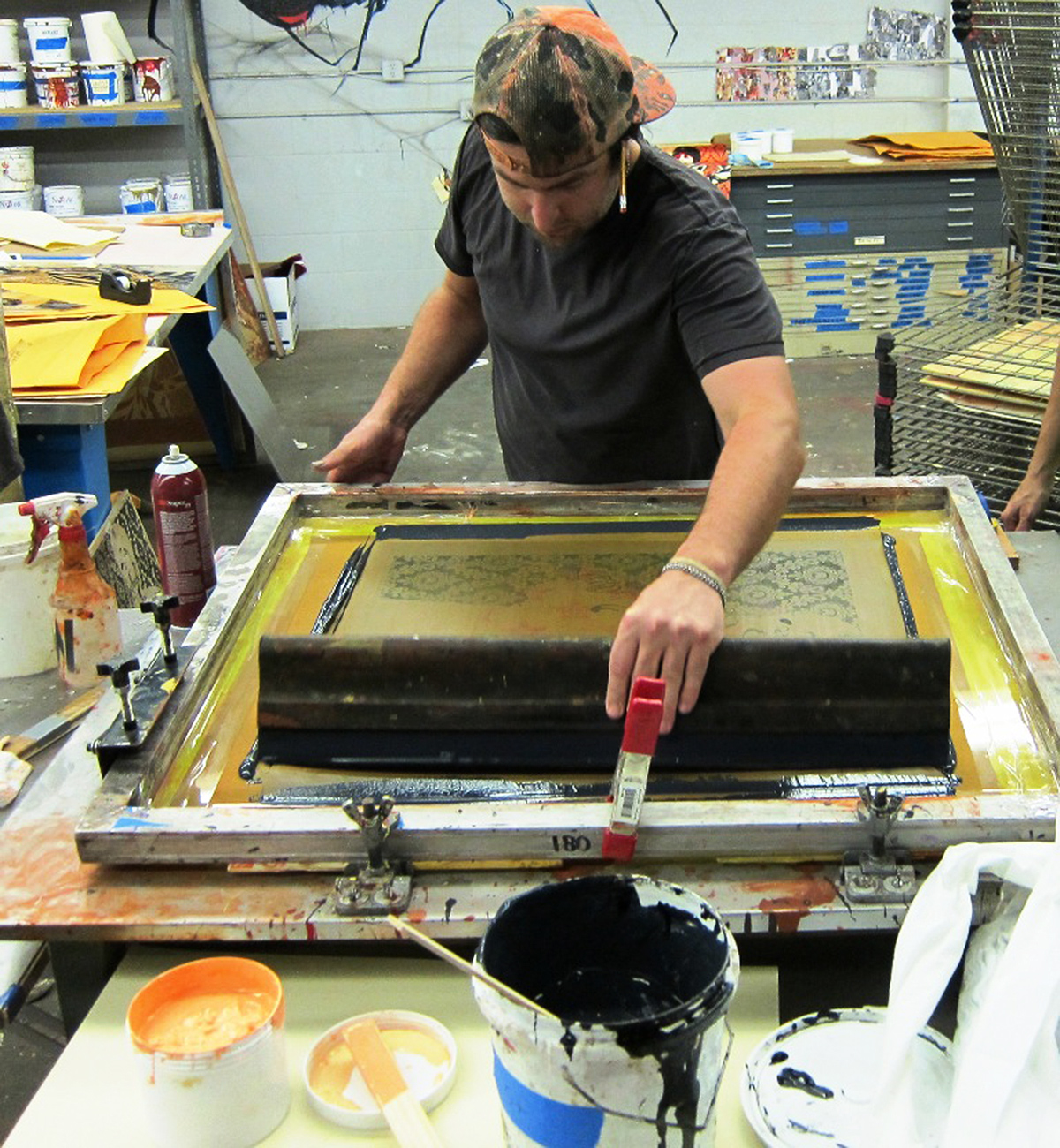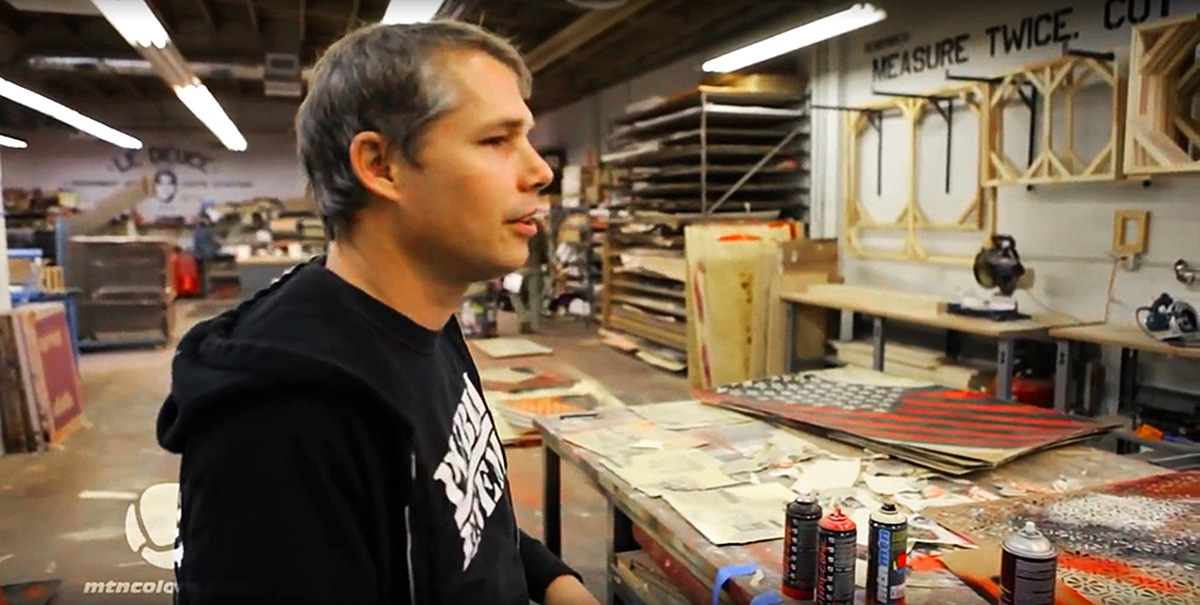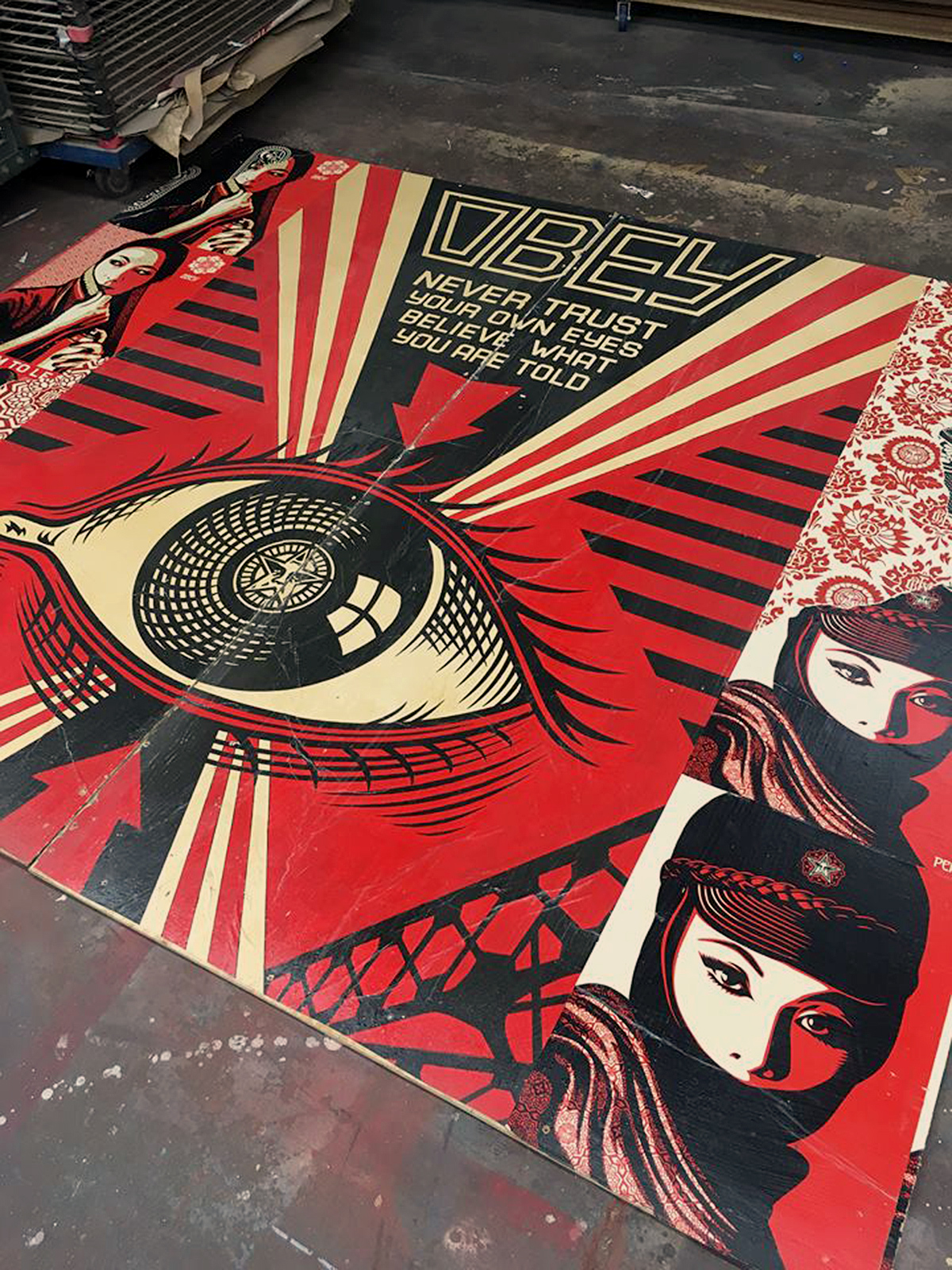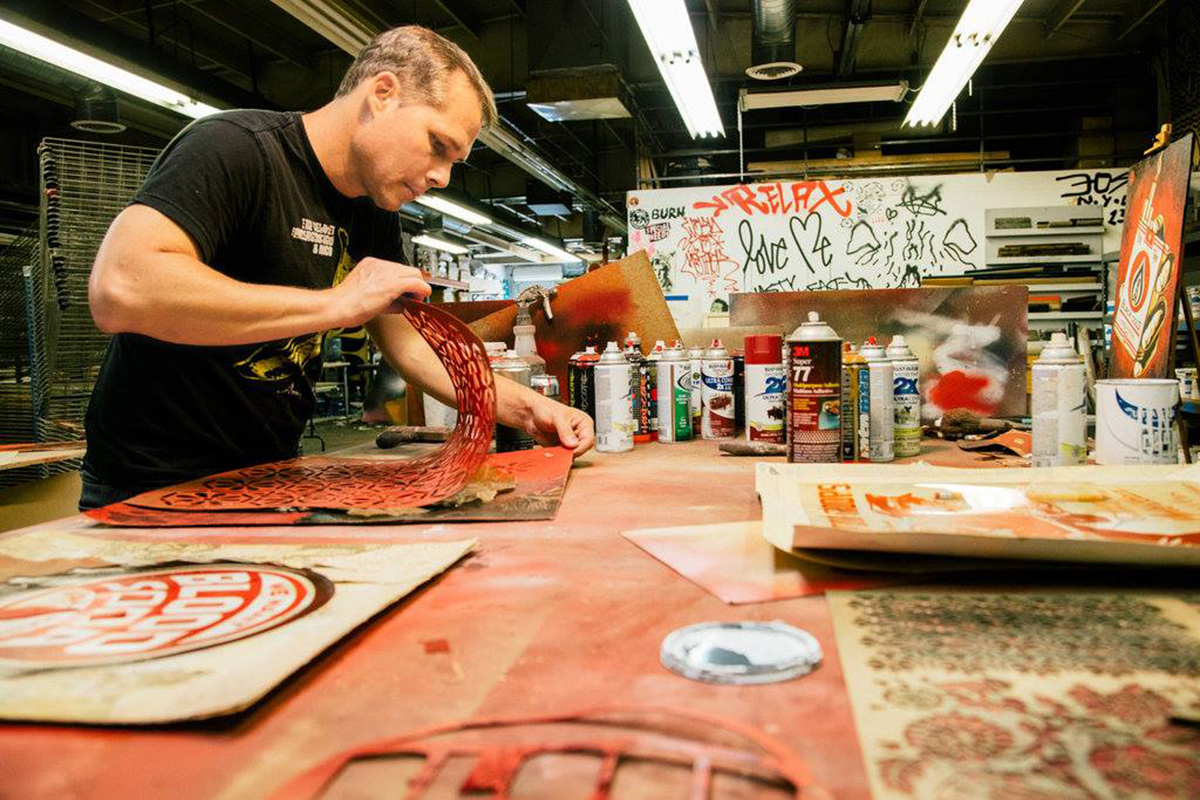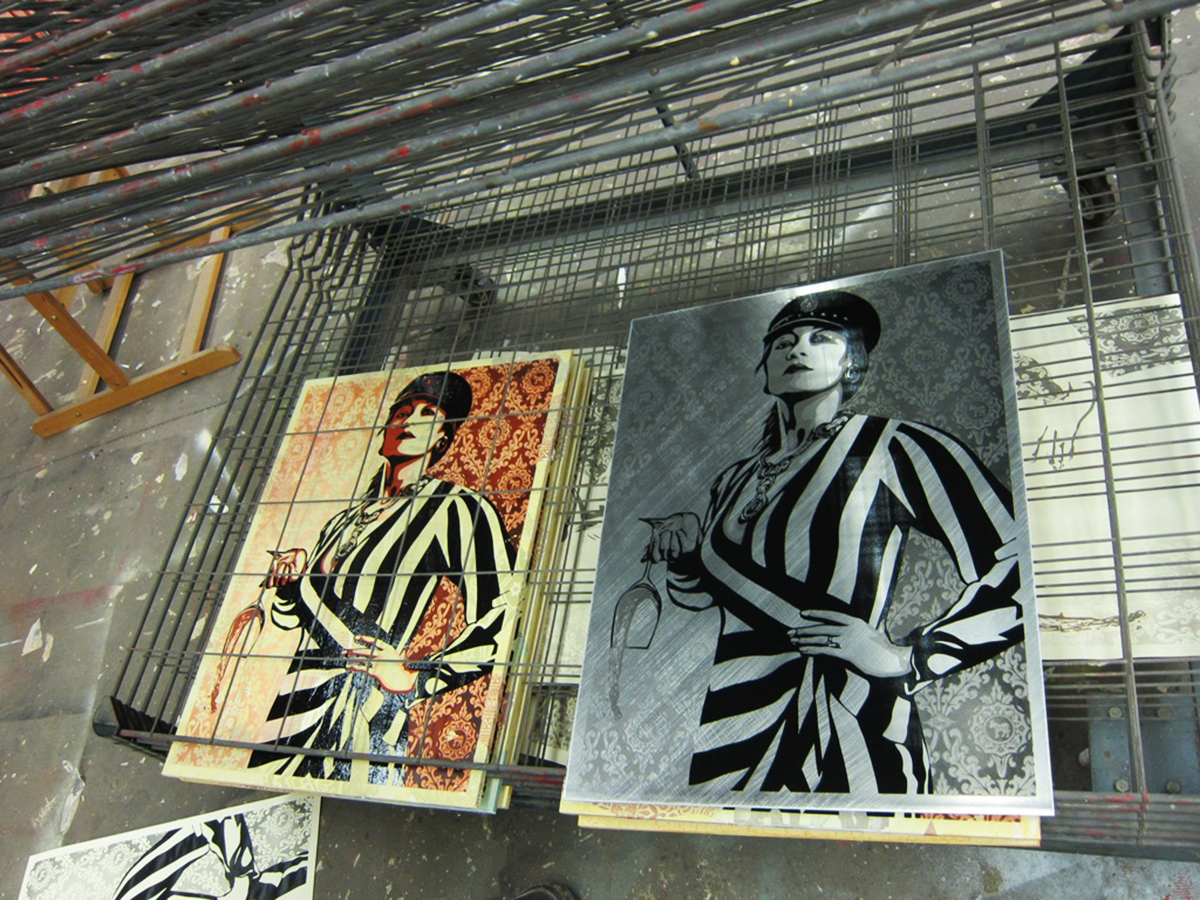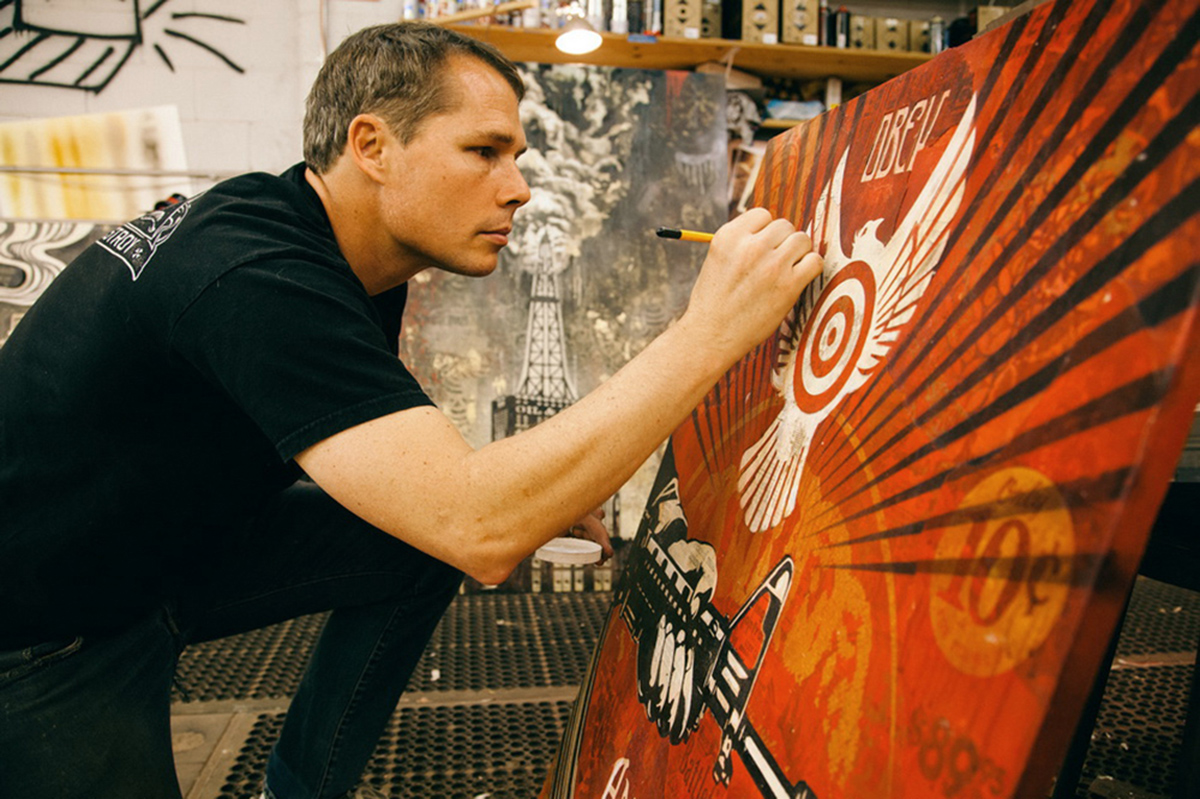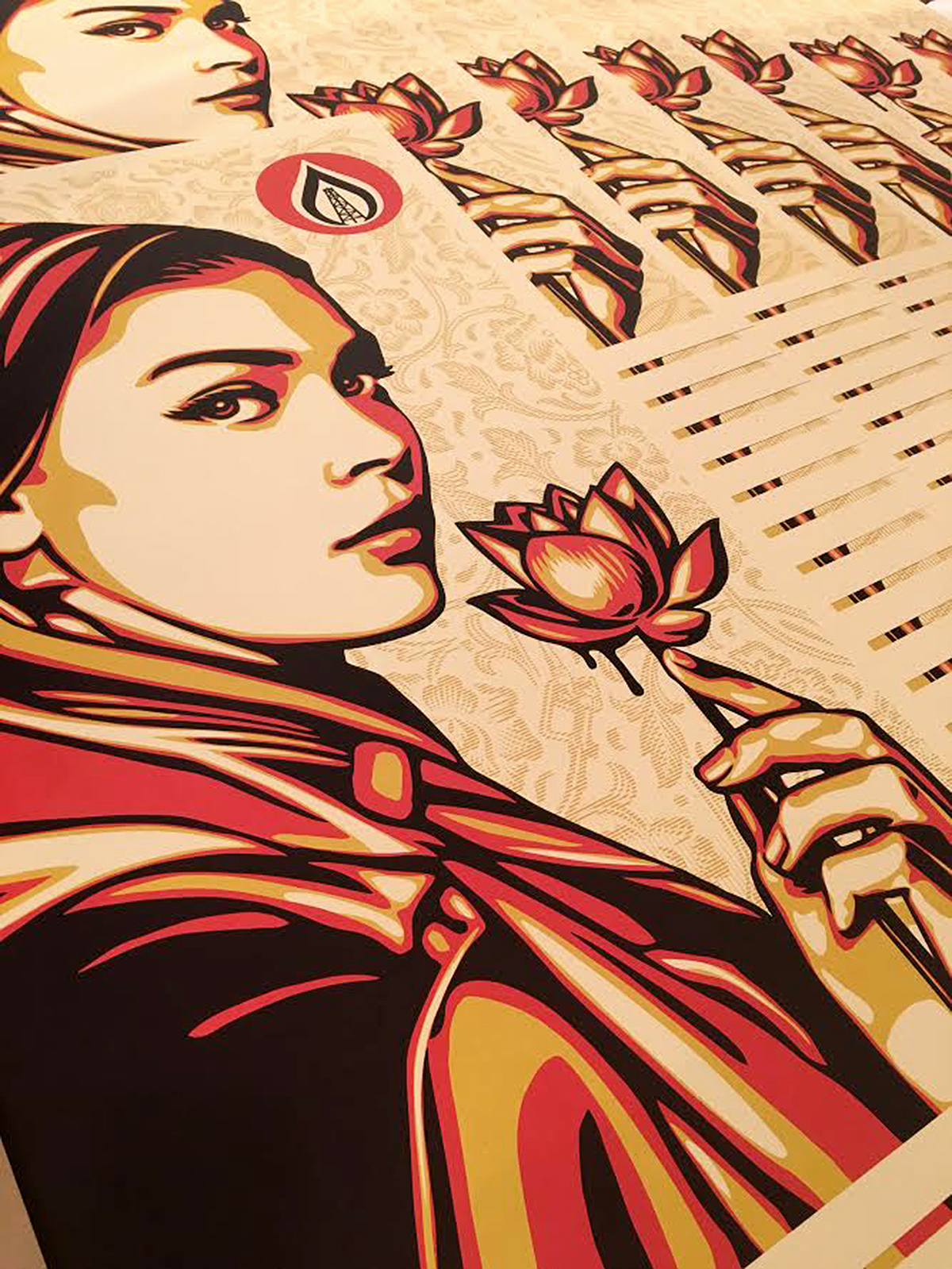The Shepard Fairey exhibition Obey to Music, curated by the Art Rock Festival in 2016 in Saint-Brieuc, brought together over 200 screenprints! Behind the activist’s mask, the artist remains that kid who grew up on rap, hip-hop, rock, and punk. What’s most striking in this tribute to music is his ability to produce such an impressive body of work—all printed at the Obey studio. So, how about a peek inside the Giant’s very own studio?
Today, it’s almost impossible to escape Shepard Fairey’s work and the Obey brand. The American artist, graphic designer, and illustrator became famous through his iconic stencils André the giant has a posse, his 2008 portrait of Obama, his massive murals, and more recently, his huge two-ton globe Earth Crisis, which was suspended in the heart of the Eiffel Tower in 2015. At 46, the street artist—who masterfully blends punk rock symbolism, pop culture, advertising, and political propaganda—remains a devoted skateboarder and stencil artist. Between his original works sold for eye-watering prices (up to $40,000), his screenprints, his Obey Clothing line, and his commitment to environmental and social causes, one might expect Obey to be nothing more than a brand—an engine for mass-produced, commercial merchandise. Yet, he remains the undisputed master of a style, a body of screen prints that, just a few years ago, were sold at very affordable prices (between $35 and $80 for most of them).
Shepard Fairey set up the small world of Obey Giant in Los Angeles’ Echo Park neighborhood. In this strange two-story brick building at 1331 W. Sunset Blvd, you’ll find the charming offices of Obey Studio Number One: the advertising agency he has run since 2003 with his wife Amanda.
The studio follows a creative and promotional philosophy where, according to them, art and business intersect! Among their clients are some of the world’s biggest brands: Coca-Cola, DC Shoes, EA Sports, Google, HBO, Levi’s, MTV Films, Nike, Pepsi, Rolling Stone magazine, Sony Japan, Virgin, Universal Pictures, and more. Clearly, Shepard loves contradiction, since the Obey slogan was originally used to mock the enslavement of advertising and billboards!
If Andy Warhol had his Factory, Shepard Fairey has his “garage.” After passing through the entrance of his Subliminal Projects gallery, you finally discover the Obey studio. More specifically, The Deuce(initially named Studio Number Two) is where all his screenprints, stickers, collages, and stencils are produced. “When you walk through the door, you’re immediately hit by the loud crash of punk rock, metal, or hip-hop blasting from Shepard’s office all day long.” (Britt Harrison) 7The studio is right next door.
If you imagine that The Deuce is a beautiful space with carefully curated décor, designer furniture, and everything neatly organized, well, you’ll be disappointed! Shepard himself admits: “I dreamed of an art studio and a print shop with a skateboard ramp, working like Warhol’s Factory.” By the late ’90s, it didn’t quite work out that way, even though he was working with famous bands like Six Finger, Satellite, and Sonic Youth. He quickly found himself deeply in debt, as all the money was funneled into his street art and his t-shirt line.
Today, The Deuce is a warehouse housing a vast collection of spray paint cans, stencils, a laser cutting machine, screenprinting tables, and a mountain of old books and newspaper clippings used for collages. It’s sometimes so cold in there that the spray cans have to be warmed up before use! “I collect a lot of old newspapers with large illustrations and typography that can end up in my work. I love the idea that our production comes from all this accumulation of media.”
To create, Shepard also likes things to be on the floor, scattered around—scraps of screenprints, unfinished projects piled on shelves, hundreds of ready-to-use stencils in an endless jumble.
The space makes the artist feel more accessible, more spontaneous than he might appear in interviews. Far from his ideology of subversive propaganda, crouched in the studio, Shepard continues to painstakingly spray stencils with patterns that will add the final handmade touch to screenprints. Using metal or wood surfaces hand-painted, he and his team print color by color on sometimes very complex screenprints with rather rudimentary tools. It’s surprising.
“All the techniques I use in my artwork are things a 17-year-old kid can understand.” Today, it’s impossible to imagine the Obey graphics without the use of screenprinting. His biggest artistic influences aren’t paintings, but printed materials like album covers, skateboard graphics, flyers, and t-shirt prints. In college, he first began using screenprinting to blend illustrations, photographs, collages, and graphic designs. “My style started to evolve when I tried to make images that were perfectly suited for screenprinting production.”
Since his first street collages (the iconic Obey Giant wrestler stickers), Shepard has worked with a very limited color palette: black, cream white, red, and blue—all from the Montana paint brand. In the beginning, using red and black was even a trick to print posters as cheaply as possible. He also made prints in a consistent size and color palette, so they could be combined for large outdoor installations—smart thinking.
Though Shepard has always used computers to finalize his graphics, what he loves is experimenting, surgically applying small masking tape strips, before spraying the stencils to add texture to his pieces. “Today it’s very easy to create digital images, but the tactile aspect of the object is a visceral experience. Each piece has a lot of energy and tells a unique story.”
Since 1996, Shepard Fairey and his team have created and printed 670 original screenprints in the Obey Studio, totaling over 100,000 posters sold, including numerous color variants and about ten letterpress prints produced by the Aardvark Letterpress studio.
His particular fondness for cream white is such that his 18 x 24″ (45 x 60 cm) posters are almost always printed on the same recycled paper: French Paper Speckletone Cream. The production pace is phenomenal! Since 2001, more than forty screenprint designs have been produced every year. While posters for The Black Keys or the All Tomorrow’s Partiesindependent music festival were printed in editions of 550 and 600 copies, most editions rarely exceed 100 prints. However, there are rarities like the 20 Year Retro Series Set, printed in only 75 copies in 2009, which sold for $2,000.
From the street to the high-end luxury market, Shepard Fairey’s style continues to captivate. Accused many times of plagiarism (and rightly so), Obey’s work raises questions when it parodies or appropriates old advertisements, propaganda posters from the Red Army, Chinese, American, and especially those by Rodchenko. (Read this article and this one to form your own opinion.) His 2014 collaboration with Hennessy Cognac also raises questions about his independence from brands.
This is the darker side of the giant: behind this massive production, sometimes (unfortunately) printed in offset, lies a disparity of styles and varying graphic quality, even when created by the fifteen employees who make up the creative and technical staff at Obey Studio.
However, Shepard Fairey keeps a close eye on every creation. He has always been the first to admit that he wouldn’t have gained as much recognition without the help of his friends (who have now become his collaborators), especially Nicholas Bowers, an artist and graphic designer who has been Shepard’s right-hand man for 10 years.
For the past 20 years, Obey’s aesthetic has invented a chic radicalism and a “revolutionary” design that leaves no doubt about the artist’s talent.
Since his “hypnotic” wrestler posters in 1998, which confronted passersby with a single slogan: “OBEY,” he has learned to outsmart the supremacy of brands—he simply had to stick his own in their place…
Natural Springs by Shepard Fairey (2015) in Obey Studio. 18 x 24 inches. Screenprint on Speckletone cream paper. Edition of 450 copies.
“Some say printing will be destroyed by digital media. I think you’ll never replace the provocation, the tactile experience of a poster on the street with a painting in a gallery. Printing remains essential.” Shepard Fairey.
Discover all of Shepard Fairey’s posters on his website: www.obeygiant.com
Photos courtesy of sleepboy / uggernut3 / Jon Furlong
Obey Giant Art / Source : www.arrestedmotion.com
Article and translations by Stéphane Constant © 2016 Dezzig.


